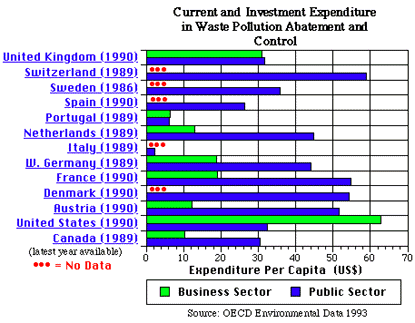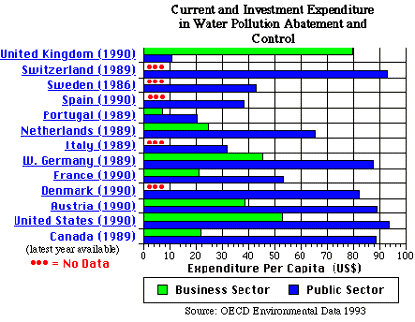Environmental costs and competitiveness -- Part 1

The author in this article and the next discusses environmental compliance costs and competitiveness.
By David L. Russell
Global Environmental Operations Inc.
Environmental compliance cost-and-competitiveness affects us all. The U.S. is spending more on environmental compliance than any other nation in the world, and that's true even on a per-capita basis or as a percentage of investments. The supporting sources for this statement are relatively dense economic summaries, which, however, contain some interesting gems about how we got to our present condition.
Once about every 10 years, the United Nations and various other offices take a comparative look at how much each country is spending on environmental compliance. Interestingly, the survey takes about four years to complete and the most recent survey data, for 1989 to 90 (posted on the Resource Renewal Inc. website at http://www.rri.org/envatlas/graphs/graphdir.html, contain some surprises about the amount of money that the USA spends on environmental control.
The USA is spending more on environmental control than any other country on the planet.
The USA is playing on a non-level field where environmental regulations are imposing a penalty on the country. This out-of-balance spending is adversely affecting its industries and ultimately its jobs.
For those of you who haven't noticed, the country is rapidly losing its competitive position in manufacturing capacity—losing its ability to compete on the international equipment market. So the subject of spending on environmental control really is all about U.S. competitiveness and trade.
Mine is not a plea to reduce environmental expenditures or to turn back the clock. But it is a call for awareness and dialog with other countries.
To keep comparisons relevant, you have to look at countries having comparable economies. (It is simply invalid to compare a third-world country with the USA, Germany, England, or any of the principal EU countries.) The following graphic illustrates my point.

U.S. per-capita pollution control expense one-third greater
The figure indicates that the U.S. per-person expenditure for waste-pollution control alone in 1990 was approximately U.S.$100 per person ($64 + $33), and that—most meaningful—more than 60% of the amount was borne by business. The closest countries with similar expenditures (discounting Switzerland, for which business outlays are unavailable) are West Germany (pre-reconstruction) and England with about $64 and $60, respectively.
The next graph shows expenditures for water pollution, principally sewage-treatment works and the like. The per-capita U.S. expenditure is about $148 per person and that, of other countries having comparable expenditures, the closest are Austria and West Germany with about $135 per person per year.

The combined U.S. investments for water-pollution control and garbage and hazardous-waste disposal translates as a per capita cost of $250 per year—or just about $1,100 per year for the typical U.S. family—a mom, dad and 2.1 children.
I'm not going to argue whether these levels of cost are right or wrong. But I will argue that America needs to be aware that it is spending more money on environmental control than any other country on this planet.
What is it getting for getting its money?
Next, I'll look at the breakdown of expenses as it relates to industrial competitiveness.
About the author: David L. Russell is a PE and a principal of Global Environmental Operations Inc., 4642 Warrior Trail, SW, Lilburn, GA 30047. Tel: 770-923-4408. Fax: 770-781-8004.
